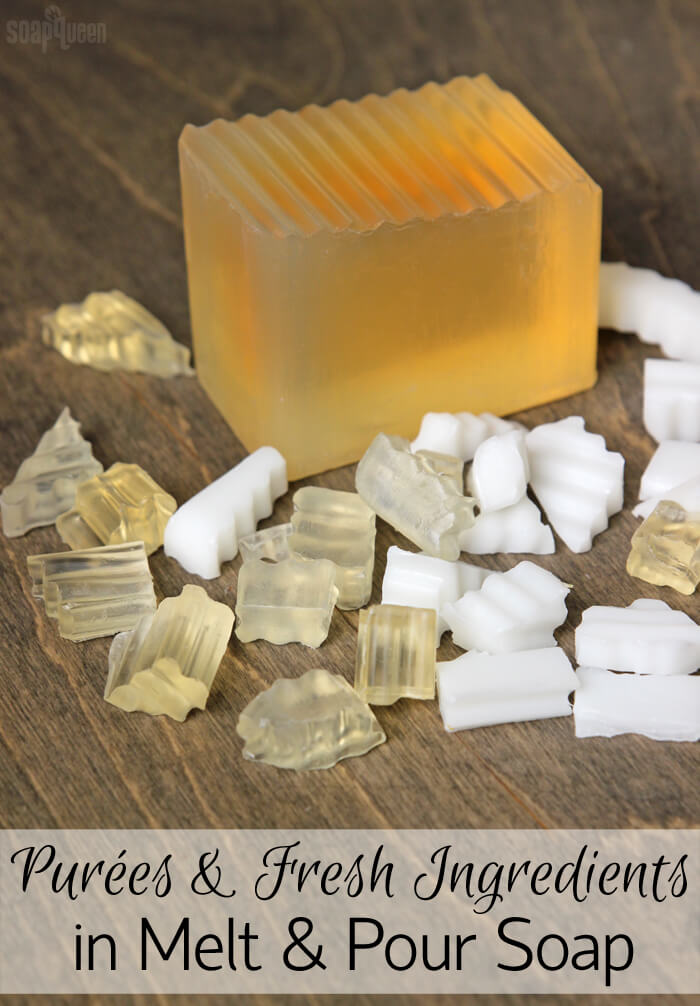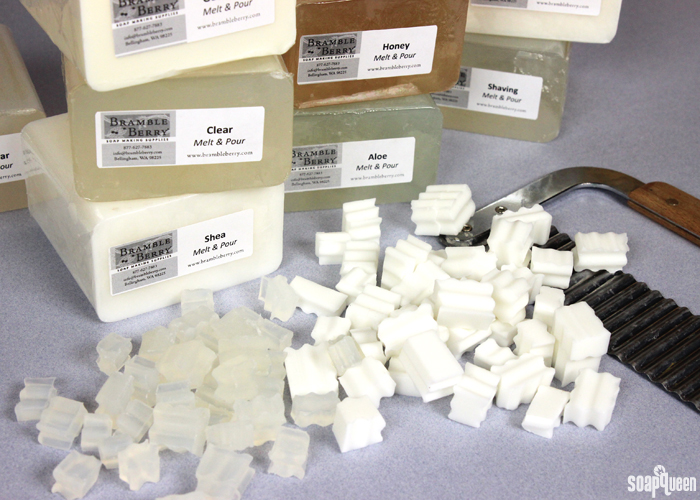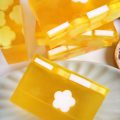
I love how a block of melt and pour soap base can be transformed into so many things. If you take a peek at the melt and pour section of this blog, you can see just how many possibilities there are. From color and fragrance to exfoliants and embeds, there are so many design options. It’s easy to understand why crafters of all skill levels enjoy it!
Despite the vast possibilities for melt and pour, there are a few additives that don’t work well. Fresh ingredients like purees and milk are at the top of the list. To understand why these ingredients don’t work, it’s important to understand what melt and pour soap is. Melt and pour soap is ready-made soap that has gone through the saponification process. That means sodium hydroxide lye, oils, glycerin (and sometimes other ingredients) were combined together to make the base – just like making cold process soap! If you’re unfamiliar with saponification, this video explains the process further.
The fact that saponification has already occurred in melt and pour soap is what makes melt and pour soap “easy.” You don’t have to worry about working with lye. Melt and pour soap is ready to use once fully cooled and hardened, so it’s fast too. No cure time is needed for melt and pour. But, because saponification has already occurred, it means that you don’t have as much control over the ingredients in the soap. Ingredients that require saponification to become part of the soap (lye, oils, butters, purees, milk, eggs, etc) don’t work well when added to melt and pour.
So, why can you use fresh ingredients (purees, milk, etc.) in cold process soap, and not melt and pour? When you add fresh ingredients during the cold process soaping process, those ingredients get extra scalded and burned because of the heat and the high pH of the fresh soap. That high pH and heat scorch most anything that was once alive with the possibility of growing nasties. The extra ingredients also go through the saponification process along with the lye and oils. But in melt and pour, that chemical process has already occurred. It’s too late to properly incorporate fresh ingredients.
 Purees can be added to cold process soap batter because they will go through the saponification process.
Purees can be added to cold process soap batter because they will go through the saponification process.
Think of it this way: you made a cake, and take it out of the oven to cool. Then you realize, you forgot the eggs. Dang! Since the cake has been baked and is now cake (and not cake batter), it’s too late to add eggs. The eggs won’t mix in. It’s too late for the eggs to be turned into cake. You can still decorate the cake with frosting, sprinkles and top it with candles. But, you can’t add ingredients into the cake that require baking.
Like the cake, it’s too late to add fresh ingredients to melt and pour soap base. Melt and pour soap is fully made and is “out of the oven.” Like decorating the cake, you can still add fragrance, color, sparkle and more to the soap. But you can’t add an ingredient that needs to go through the saponification process.
What will happen if you do add fresh ingredients to melt and pour? Well, probably nothing for a while. But eventually, those ingredients will go bad. Adding a fruit/veggie purée to melt and pour soap is like leaving the purée out on the counter. Eventually it will turn brown and grow mold. The same is true for milk. Adding milk (or even milk powder) to melt and pour soap is like leaving a carton of milk on the counter. Eventually the milk will spoil. If you were to add raw eggs to your already baked cake, those eggs would go rancid very quickly.
 Some melt and pour bases already contain fresh ingredients like milk, honey and aloe vera liquid. Learn more about the various bases here.
Some melt and pour bases already contain fresh ingredients like milk, honey and aloe vera liquid. Learn more about the various bases here.
Luckily, there is a way to enjoy fresh ingredients into melt and pour projects. Some bases contain coveted fresh ingredients like milk and honey. The SFIC Goat Milk Melt and Pour Base contains 10% liquid goat milk. In the SFIC Honey Melt and Pour Soap, honey is the fifth ingredient which gives it a lovely, warm color. The SFIC Aloe Vera Melt and Pour contains 5% aloe vera gel. These ingredients are added during the saponification process, so they won’t spoil. =) Browse all the melt and pour bases here.
If you prefer adding those ingredients yourself and want full control over the recipe, cold process soap is the way to go. If you’ve never made cold process soap before, I recommend starting with some very basic recipes before working purées, milk and other fresh ingredients. Fresh ingredients complicate the process, so it’s good to get the basics under your belt first. If you’d like to learn more about working with fresh ingredients in cold process soap, check out the blog posts below!
How to Add Purees to Cold Process Soap
How to Add Lye to Milk for Cold Process Soap
Adding Honey to Cold Process Soap: Tips, Tricks & Recipe
How to Use Honey in Bath & Body Products
Buttermilk Bastille Baby Bar on Soap Queen TV





I for one have been adding castor oil and honey on my melt and pour goat milk and it works wonder it doesnt turn bad at all I use it within one month though so I dont know maybe its because of that…
It could very well be because you are using the soap so quickly. Over time the soap can eventually turn brown and mold when fresh ingredients are added to melt and pour soap.
Many thanks for this article it was very informative. I need your assistance with a problem I am facing. I want to make leather and saddle soap and sell from my online Amazon account here in India (saddle soap is not available here). The problem I am facing is that I want to sell this soap poured into a container like most other saddle soaps. Melt and pour soap bases are readily available here, but as mentioned in this article I cannot really add what I want to, in this case, coconut milk, coconut oil and lanolin. I gave up on the idea of beeswax after reading from several sources that it is problematic.
If I make cold process soap, it would need to be cured. perhaps the best option for me is to make melt and pour soap base of my choice in some quantity and then melt and pour into my 150 ml containers as and when required. This option is difficult because I am new to soap making. It would be nice if you could help with the following.
Is it possible to cure cold process soap that has been poured into a plastic container?
How difficult is it to make a melt and pour soap base with coconut oil, coconut milk and lanolin.?
Your suggestion on what I should do?
Regards,
Mehran.
We’ve tried making melt and pour soap and haven’t found a recipe that works well. Cold process would be a better option if you want to add coconut oil, coconut milk, and lanolin.
Learn how to work with milk in cold process soap here: http://www.soapqueen.com/bath-and-body-tutorials/tips-and-tricks/how-to-add-lye-to-milk-for-cold-process-soap/
Lanolin: https://www.brambleberry.com/Lanolin-Ultra-Refined-P6576.aspx
Coconut oil: https://www.brambleberry.com/Coconut-Oil-P3196.aspx
You can cure cold process soap in a container. Just leave the top off and let the soap sit in a cool, dry place with lots of airflow. That’s what we did for this shaving soap recipe: https://www.soapqueen.com/bath-and-body-tutorials/cold-process-soap/cold-process-shaving-soap-soap-queen-tv/
can we use hydrosals in melt an pour soaps?its said essential oil should be dilute with other oil so how can we use directly in soaps?
Once you add the essential oil to your melt and pour soap, it is diluted. That means you don’t have to mix the essential oil with anything before adding it to the recipe.
You can use our Fragrance Calculator to find out how much to add to your batch: http://www.brambleberry.com/Pages/Fragrance-Calculator.aspx
Essential oils: https://www.brambleberry.com/Essential-Oils-C157.aspx
Can we use collagen powder in a melt and pour soap base or will that make the soap go bad?
We haven’t worked with that powder a lot so I’m not sure if it would mix into the soap base well. You may check with the manufacturer to see if they know more.
Hi,
love your website! Quick question – have you tried using pasteurized juice for Melt and Pour soap? I made m&p soap with fresh home made carrot/spinach juice few weeks ago and result is very good, but after reading your post I’m afraid that soap can go bad after a month or two and my Christmas presents will go right in to the waste bin. I have several blocks of m&p soap base already and want them to make as natural as possible, that’s why I used fresh juice for coloring in the first place. So to sum up this long post – pasteurized juice – yes or no for m&p soap? Thanks!
We haven’t given it a try so I’m not entirely sure. I’m thinking it will go brown like regular juice. You can try a small test batch, or to be extra careful you can use soap colorants like mica. They add color without affecting the shelf life.
Find melt and pour colorants here: https://www.brambleberry.com/For-Melt-Pour-Soap-C450.aspx
And learn how to work with them here: http://www.soapqueen.com/bath-and-body-tutorials/tips-and-tricks/talk-it-out-tuesday-colorants/
Hi..same with me..yesterday i joined making M&P soap…we were taught how to add puree /fresh ingredients to the soap..and we made..coffee M&P soap,tomato M&P soap(puree only no water) and oat M&P soap..so far nothing happen..but as soon i read this..kinda scared something might happen in the future..the soapmaker taught us that carrier oil and essential oil extend the shelf life..is tht true?
Eventually that soap will turn brown and the ingredients will go bad, even with a carrier and essential oil.
What about adding vitamin E Oil? Isn’t that a good preservative?
Vitamin E oil can help extend the shelf life of the oils, but it won’t prevent the fresh ingredients from going bad. Learn more in this post on preservatives: http://www.soapqueen.com/bath-and-body-tutorials/lotion/talk-it-out-tuesday-preservatives/
Vitamin E oil: https://www.brambleberry.com/Vitamin-E-Oil-P3200.aspx
Just checking for clarification were they a dried powder form? Dried ingredients like oatmeal, dry coffee grounds, dry tomato powder shouldn’t present an issue as they are already processed. Just don’t premix them with water, use liquid glycerin or small amount of melt and pour if you want to blend in easier.
Hi,
I love your website! I was wondering if it is possible to add magnesium oil (dead sea salts and distilled water) to melt and pour soap in a small amount? Thanks
We have not experimented with that exact combination, so if you give it a try let us know! In general though, we like to add very small amounts of extra oil to melt and pour soap, because it can decrease the lather. Adding extra water can also increase glycerin dew. If you want to experiment with it, I would recommend a small test batch first to see what you think.
-Amanda with Bramble Berry
I have some hemp soap in my basket along with a bunch of other items from BB to make my first ever batch of soap.
I have eczema which is crazy itcy and I’ve decided to make my own ‘Neem & Moringa’ soap, body scrub and body butter to “heal” myself. I’m pretty crafty but have never made any of these items.
Would the below recipe work for a melt and pour soap base or does the quantities need adjusting? Please help if you can, thanks!
-2 lbs hemp soap base
-1 lb aloe vera soap base
-3 oz Shea Butter
-1 oz neem oil
-1 oz moringa oil
– .5 oz moringa extract
– .5 oz neem extract
– 6 tsp neem powder
-15 g tea tree and lemongrass essential oil mix
I wanted to make enough to fit the 10″ silicone loaf mold on your site. Any help with the recipe would be much appreciated so I can go ahead and make my purchase!
I’m so excited to try and I realize I’m going real BIG on a first try but I’m happy to do so.
Thanks again, Nekisha.
PS – can i mix the neem powder w/ the extracts to incorporate or must it be alcohol?
I just realized it probably makes more sense to use 1 lb each of the hemp, aloe and shea soap base instead of adding the shea butter separately although I’ve found a recipe online with someone adding shea butter to their M&P base.
Can’t wait to have your feedback! 🙂
We don’t recommend adding extra oil and butter to the melt and pour bases. Because they’re already made, it can make them dry, oily, or inhibit lather. If you do add extra oil, we recommend no more than 1 teaspoon per pound of soap.
Instead, you can use the bases on their own. They feel great on the skin. Read more about them here: https://www.soapqueen.com/bath-and-body-tutorials/tips-and-tricks/sunday-night-spotlight-melt-and-pour-bases/
If you like customizing, you may like cold process soap. It allows you to choose all the oils that go into your batch. Learn more about getting started here: http://www.soapqueen.com/bramble-berry-news/beginning-soaper-resource-roundup/
This four-part video series is helpful as well: https://www.youtube.com/watch?v=yR6ttCSrLJI&list=PLAADF6209996265D2
-Kelsey with Bramble Berry
Can you use pureés in sugar scrubs? Sorry, I know not soap related but I just need some help/advice!
I missed this question, sorry about the late response Lori. We don’t recommend fresh fruit in scrubs because it can mold and shorten the shelf life to just a few weeks. Fruity fragrance oils are a good option instead: https://www.brambleberry.com/Fruity-C166.aspx
Learn how much to add with our Fragrance Calculator: https://www.brambleberry.com/Pages/Fragrance-Calculator.aspx
-Kelsey with Bramble Berry
What about olive leaf powder or spirolena powder in melt and pour?
I missed this question, sorry for the long wait. Both work well in melt and pour. We recommend mixing 1 teaspoon of powder with 1 tablespoon of 99% isopropyl alcohol. That will help it mix in easily. Then, add 1/4 teaspoon of the dispersed color at a time until you get a color you like.
We used spirulina in this melt and pour soap: https://www.soapqueen.com/bath-and-body-tutorials/melt-and-pour-soap/minty-clay-melt-pour-bar/
-Kelsey with Bramble Berry
What about ground oatmeal? Does this go bad in a melt and pour soap
Ground oatmeal will work just fine! It helps add soothing properties to soap. It can be added up to 5%. It helps to mix the oatmeal with alcohol before adding it to soap. That makes it mix in smoothly and clump free. 🙂
-Kelsey with Bramble Berry
Colloidal oatmeal: https://www.brambleberry.com/Colloidal-Oatmeal-P5565.aspx
Are you able to put dried herbs/flowers into melt and pour (glycerin or goats milk)?
You can add dried herbs and flowers to melt and pour soap! However, they will turn brown inside the bars. That is something to keep in mind. 🙂
Learn more in this Soap Queen TV video on using herbs: https://www.youtube.com/watch?v=G3VbeNl1Nqg
-Kelsey with Bramble Berry
What about oil? Can I add other or extra carrier oils to my soaps for added benefit?
We don’t recommend adding extra oil to the bases. Because they’ve already saponified, extra oil can make them greasy or crumbly. If you do add extra, we don’t recommend more than 1 teaspoon of oil per pound of soap. That should give you the benefits of the oil without affecting the texture too much. 🙂
-Kelsey with Bramble Berry
Honey as an additive is mentioned. If honey is added in m&p soap, the soap will go bad? If so, will vitamin e help at all?
Thanks.
You can add honey if you like! It has quite a long shelf life. We’ve found too much honey in the base does make the soap quite a bit softer though. You can learn more about adding it here: https://www.soapqueen.com/bath-and-body-tutorials/tips-and-tricks/use-honey-bath-beauty-products/
We also have a lovely Honey Melt and Pour Base you may like! It feels great on the skin. 🙂
Honey Melt and Pour Base: https://www.brambleberry.com/SFIC-Honey-Melt-And-Pour-P3186.aspx
-Kelsey with Bramble Berry
I love that you put “easy” in quotes! I hear people say all the time, “Oh, melt and pour is cheating, because it’s so easy! Not like REAL soap making!” I always just laugh because I do both M&P and CP and find CP so much easier/less time consuming.
I agree! If you are doing any kind of layering, complex coloring, embeds etc with melt and pour, I find it much more taxing and time consuming and a lot of different steps and waiting to complete a project! The results may be more immediately usable, but it’s a more involved process.
Absolutely, melt and pour soapmaking requires some definite skill and patience! We admire melt and pour soapmakers and cold process soapmakers alike. 🙂
-Kelsey with Bramble Berry
How do you feel about adding fresh ingredients to the base? Will keeping it in the fridge AND adding vitamin E oil help it to keep from going bad too soon?
I have made a recipe with shea butter base, coconut milk and coconut oil. love the soap so creamy! Is coconut milk different. Is there a preservative that I can add to prevent this? Will my soap go bad?
Hi Debbie!
Even with a preservative, the soap can spoil. Preservatives help prevent mold and bacteria growth but they don’t extend the shelf life of milk. We don’t recommend it in melt and pour soap. We do recommend our Goat Milk Melt and Pour Base though! It feels really nice and creamy. 🙂
Goat Milk Melt and Pour: https://www.brambleberry.com/SFIC-Goat-Milk-Melt-And-Pour-P3184.aspx
-Kelsey with Bramble Berry
Great article! I add coconut milk powder directly to my M/P base. Not much maybe 1Tbsp per pound. I have not had any issues as described above. Do you think that is because I am just lucky so far or because its plant based and I did not add water to reconstitute it. I am wondering if this is a practice I should stop. It does lend a lovely creaminess to the bar.
Hi Deborah!
Usually the coconut milk powder can rehydrate and shorten that shelf life. If you like the feeling, you can definitely keep adding it! Just keep a close eye on the soap. If you notice it change colors or notice an off smell, you may want to toss it. We’ve found soap made without that powder lasts a bit longer. 🙂
You may also like our Goat Milk Melt and Pour Base, which feels nice and creamy: https://www.brambleberry.com/SFIC-Goat-Milk-Melt-And-Pour-P3184.aspx
-Kelsey with Bramble Berry
Hi: I’ve always been curious about melt and pour (I did try it once). If it is saponified oils and lye, what is the difference between it and cold process soap? Why does it melt so easily while cold process would just scorch? Could one make his/her own melt and pour base? I’ve never seen any recipes.
Thanks!
Melt and Pour soap is a fully saponified soap base. So it’s already soap. All you have to do is melt it, scent it, color it, and pour! It’s very easy. But you can’t control what oils, butters, purres, and milks go into it.
Hi Eric!
The main difference is the manufacturing process! Melt and pour starts out like cold process soap, but I believe it is cooked sort of like liquid soap. It also has additional glycerin added. That makes it easy to melt and harden again. It has a much more fluid texture than cold process. 🙂
You can make some from scratch! We have experimented with that a couple times without a lot of luck. It is a pretty complex process. Learn more about how to make it here: https://www.brambleberry.com/Making-Transparent-Soap-1-Book-P3732.aspx
If that seems like a bit much, I highly recommend our melt and pour bases! They’re easy to work with and feel great on the skin. 🙂
-Kelsey with Bramble Berry